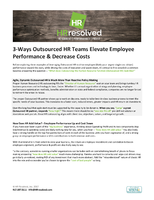Three R&D 100 Awards were earned by NREL for solar research.
Share:
Press Release Summary:
Technique to turn silicon into ink, faster solar cell assessment method, and more efficient furnace for heating solar cells, all developed by U.S. Department of Energy's (DOE) National Renewable Energy Laboratory (NREL), were named among this year's most significant innovations by R&D Magazine. NREL Director Dan Arvizu noted that these awards "demonstrate how NREL research produces market relevant results" and how investments create jobs while advancing clean energy goals.
Original Press Release:
Solar Research Earns Three Prestigious R&D 100 Awards
A technique to turn silicon into ink, a faster way to assess solar cells, and a better furnace for heating solar cells - all developed at the U.S. Department of Energy's (DOE) National Renewable Energy Laboratory - have been named among this year's most significant innovations by R&D Magazine.
The three prestigious awards bring to 50 the number of R&D 100 awards that NREL has won since 1982.
The three NREL winners all originated in fundamental science and now are on the brink of making huge differences in the marketplace.
Energy Secretary Steven Chu noted that 36 of the 100 awards were given for research in the nation's federal labs and facilities. "The cutting-edge research and development done in our national labs (and sites) is helping to meet our energy challenges, strengthen our national security and enhance our economic competitiveness. It is gratifying to see their work recognized once again."
Turning silicon into ink saves money, improves quality
NREL scientists led by Photovoltaic Incubator Subcontract Technical Monitor Richard Mitchell teamed with Innovalight, Inc. to invent silicon Ink, a liquid form of silicon, and develop it for use in solar cells.
This marks the first time that silicon has been sold in the marketplace as a liquid. With the Innovalight Silicon Ink process , a screen printer is added to the manufacturing line, which produces an immediate increase in solar cell efficiency by allowing lighter doping thus enhancing response to the blue portion of the spectrum.
The new product boosts the bottom line of a typical solar production plant by 20 percent, which for an average-size factory is $100 million, while boosting the efficiency of the cells by about 6 percent.
Faster assessment of solar-cell quality
NREL scientists teamed with Tau Science Corporation to develop "Flash Quantum Efficiency System for Solar Cells," a way to assess the quality of solar cells at a speed that is about 1,000 times faster than previous methods.
The instrument - Tau markets it as FlashQE(TM) -- uses light-emitting diodes, high-speed electronics and mathematical algorithms to measure the quantum efficiency of solar cells orders of magnitude faster than before. What used to take 20 minutes - and therefore could be done only with random samples of cells - now can be done in a second, said NREL Senior Scientist David Young.
That means every single cell on a manufacturing line can be assessed and provide much needed process feedback information to the line and each cell can be sorted by its spectral response. Cells that respond best to, say, red light can be connected together to form a solar module. That way, a mismatched blue-response cell on a module won't put the brakes on all the work the red-response cells are doing. And that means more efficient conversion of photons into electricity at sunrise and sunset when the red wavelengths predominate.
NREL's Optical Cavity Furnace bolsters efficiency, lowers cost
The NREL Optical Cavity Furnace could revolutionize the solar cell manufacturing industry in the U.S. by producing higher quality and higher efficiency solar cells at a fraction of the cost of conventional, thermal ovens. The new furnace, which uses photons to uniformly heat crystalline solar cells and semiconductor materials, has increased the efficiency of the cells by 3 to 4 percent, said NREL Principal Scientist Bhushan Sopori. And it costs 75 percent less than an industrial thermal or infrared furnace.
The Optical Cavity Furnace, licensed to AOS Solar Inc., uses light enclosed within a highly reflective chamber to achieve a level of temperature uniformity that is impossible with other furnaces. It virtually eliminates energy loss by lining the cavity walls with ceramic materials of high reflectance and high thermal insulation, and by using an optimal geometric design.
AOS Solar manufactured the furnace, which the company branded as the Optical Processing Furnace, and it is operating at NREL's Process Development Integration Lab, noted AOS CEO Anikara Rangappan.
"The awards demonstrate how NREL research produces market relevant results. These investments create American jobs while at the same time advancing our goals toward a clean energy future," NREL Director Dan Arvizu said.
More on NREL's photovoltaics research can be found at www.nrel.gov/pv/.
49th year of Awards for Innovation
A full list of this year's winners is available at www.rdmag.com.
The winners represent a cross-section of industry, academia, private research firms, and government labs, according to a statement by the magazine's editors. Winning technologies are used in medical, industrial, research, consumer, and manufacturing applications.
Since 1963, the R&D 100 Awards have identified revolutionary technologies newly introduced to the market. Many of these have become household names, helping shape everyday life for many Americans.
Winners of the R&D 100 Awards are selected by an independent judging panel and the editors of R&D Magazine. The publication and its online portal serve research scientists, engineers, and other technical staff members at high tech industrial companies and public and private laboratories around the world.
Winners will be recognized at the R&D 100 Awards Banquet on Oct. 13 in Orlando, Fla.
NREL is the Department of Energy's primary national laboratory for renewable energy and energy efficiency research and development. NREL is operated for DOE by The Alliance for Sustainable Energy, LLC.
Visit NREL online at www.nrel.gov




